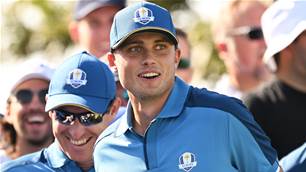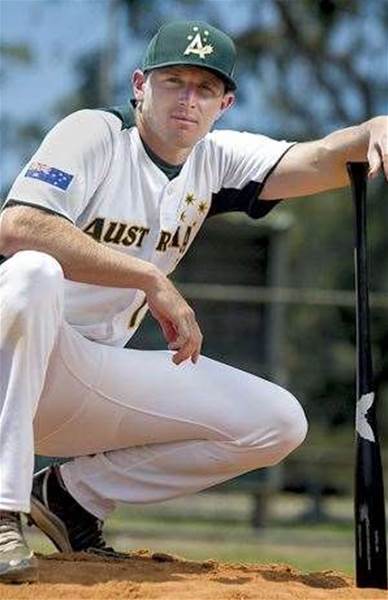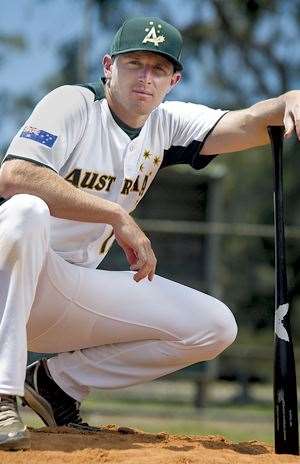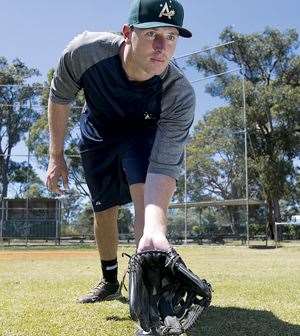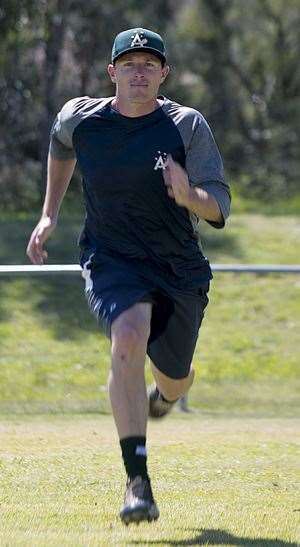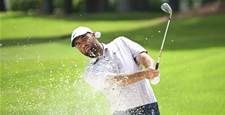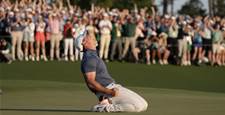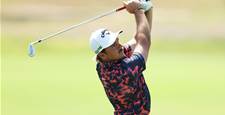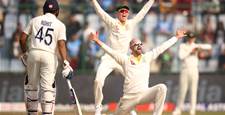Mitch Dening prepares for Team Australia's Dodgers and Diamondbacks showdowns.
Before the Arizona Diamondbacks and LA Dodgers square off in two sell-out games to open the 2014 Major League Baseball season at the Sydney Cricket Ground this weekend, they’ll each have to deal with Team Australia first (Thursday and Friday). Us Aussies have a rep for punching above our weight when it comes to America’s Greatest Pastime, a silver medal at the 2004 Olympics and fifth placings at the 2009 and 2011 Baseball World Cups proof in the damper.
The chance to perform in front of not only thousands of local fans, but the eyes of the baseball world (not to mention all those talent scouts) hasn’t been lost on Mitch Dening of the Australian Baseball League’s Sydney Blue Sox. The hard-hitting outfielder, a long-time Boston Red Sox affiliate player and Niigata Albirex troop in Japan’s independent Baseball Challenge League, has become a mainstay of the Team Australia batting order through appearances at the 2013 World Baseball Classic and against the ABL’s World All-Stars in Melbourne late last year.
“To think that two Major League clubs will be starting their seasons out here, and we’re getting the opportunity to play against them, that’s awesome – it’s exactly what we as Australian baseballers want,” Dening excitedly told us when we checked him out at a recent training session. Now all we need from you and your team-mates, Mitch, is a few homers over the walls of the SCG against the D’backs and Magic Johnson’s Dodgers. Here’s how Dening kept his body and eye in check in the lead-up to the arrival of our famous US visitors.
MAJOR CHANCE
“Major League Baseball coming to Sydney presents a great opportunity for Australian baseballers to be exposed to the highest standard of play. Our players are really starting to get televised now. Our ABL All-star game in December last year was televised on ESPN, and Team Australia played in the World Baseball Classic, which was also shown on ESPN. I went away with the Canberra team to the Asia Series and that was televised through Asia as well. So playing on television against MLB teams is only going to help again.
“Most Australians don’t realise how big baseball really is, but a lot of tickets have been sold for the four SCG games; it’s pretty impressive to see Australians getting behind the event. To see massive crowds turn up to watch two Major League clubs ... hopefully the local fans enjoy watching the season-openers, then start coming out to the Sydney Blue Sox and ABL games and help the sport grow.”
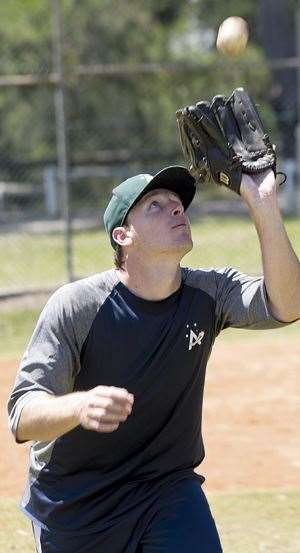 Dening will have one eye on the action, and another on the massive occasion taking place around him. Photo by Warren Clarke
Dening will have one eye on the action, and another on the massive occasion taking place around him. Photo by Warren Clarke“For a 7.30pm Sydney Blue Sox home game at Blacktown, I’ll usually get to the ground at about 3pm. We’ll have about 30 minutes of our own preparation time – that’s where I’ll go and do some early work with a tee. Then I’ll move on to what we call ‘soft-toss’. I get those two drills out of the way on my own before practice actually starts. We’ll get together as a group around 3.45pm. First we’ll have a run/stretch, performing a number of baseball-mobility stretches which we do to get ourselves in the right shape for the game so we don’t pull any muscles or suffer elbow or shoulder injuries. It’s usually about a 15-minute stretch.
“Then we move into a light catching session, just playing catch for ten minutes, before team batting practice. It usually takes an hour to give every batter on the team roughly 30 swings each.”
TEE TIME
“On my ‘days off’ I do my own batting practice up here where I live on the NSW Central Coast. I might go to a local cricket net and do my own couple of hours’ hitting off a tee, just to get the feel of the swing and make sure I’m hitting them hard and flat. I’ll even pick out targets on the net which I’ll aim to hit. Some baseballers, even in the Major Leagues in America, still use the tee every single day when they’re at the field. When I arrive at the stadium and have gotten dressed and am ready to go, I’ll place the ball on the tee and start getting loose and mentally prepared for the day. Again, I’ll pick out targets in the outfield, trying to hit them with hard, flat hits. I’ll probably take 20-30 swings off the tee.”
BAT, MAN
“Then we’ll move onto a session where a coach underarms the ball nice and soft to us, as we try to hit different targets around the ground – a landmark on the field or a distant wall, for example. The coach will stand behind a screen ... so that they don’t get hit. They’re flipping the ball underarm to you so you’re working on your mechanics, getting your sling right for the day – you’re not trying to exert yourself, rather just making sure your foot’s down at the right time and your bat path is flat and through the zone.
“Then we move into batting practice. There are groups of four guys hitting in the batting cage, which is placed on home plate. You take five swings, then rotate. You probably get about 30 more swings there, too.
“You have your hitting coach and the team manager there helping. If you’re not hitting the ball hard and flat, they’ll tell you why. If you keep hitting the ball on the ground, for instance, with no power, it’s usually because your bat isn’t coming flat through the zone, or is coming in and out of the zone too quickly. You might be trying to lift the ball, but hitting the top of the ball without having a nice, clean, flat swing through the ball square. Sometimes you’re topping the ball or popping the ball up into the roof of the batting cage, things like that. Obviously you know yourself as a professional that you’re doing }something wrong, but if you can’t figure it out after a few swings, that’s what the coach is there for.”
“You’re doing your fielding and your base-running while other players’ batting practice is going on. You usually end up taking ground balls off the person batting in the cage at the time, so you’re getting a live read off the bat. Outfielders are also getting balls hit to them, so they’re getting a read on how the wind’s going, where the sun is ... “Usually about 30 minutes before the game we all come back out and do what’s called infield-outfield. Players take their positions for the day, and a coach will hit five balls to each fielder so we know how the ground’s playing and so we can air our arms by throwing balls to the basemen.
“By game time you’re well and truly warm, loose and ready to go. That’s the whole idea of it. The first pitch of the first game of the series could be the best one to hit, so you have to be ready to hit it.”
HEALTH NOT HOTDOGS
“On game day I’ll usually have a fruit-and-yoghurt in the morning; a granola with fruit and yoghurt and a piece of toast, something like that. I’m not a big eater on game days ... I’ll get it all in over the off-season! I don’t usually have anything heavy before I take the field. I don’t know if it’s a nerve thing, it’s just something I’ve always done. If I’m on a nice, hot hitting streak, I’ll keep the same routine until something’s broken. Depending on what time the game is – if it’s a 7.30pm game – I’ll have time for some lunch. The staff puts on meals at the ballpark every day, whether it’s sandwiches, fruit again, small snacks, meat and salad spreads, rolls ... I’ll have a pretty big dinner – like a steak and veggies – after the game to get myself ready for the next day.”
“In the off-season, as I’m returning home from playing overseas, I usually hit the gym hard, completing anywhere from seven to nine gym sessions a week. It’s the only opportunity I’ll get to build my body up for the upcoming Australian season.
“Your legs and core are the most important weapons for baseball; you’re building your legs up really strong by doing squats and leg-presses, lunges, box-jumps ... To hit the ball over the fence, you need power, and that’s where all the power is, in your legs and core. We do a lot of core work, a lot of abs and a lot of medicine ball stuff to help with rotational strength.
“I do work on every part of my body, though. I’ll go in and might do legs three times a week, but I’ll split it up. I’ll come in on a Monday and do a leg and an arm-focussed session, then Tuesday I’ll come in and do a chest and a back. But then I’ll go straight back into my legs again the next session.
“I played in the Boston Red Sox’ organisation for six years in America and that’s what they preached: legs and core. So I’ve worked that into my workouts back here in Australia. To get through 140 games in America or Japan you need to be fully fit. You play every day overseas; it’s too hard to maintain your strength if you aren’t strong when you head over.”
GAME OF FAILURE
“In baseball, if at every third at-bat you get a safe base hit [you reach at least first base without being run out], you’re an all-star; whenever I see a .300 average next to my name, it’s been a great season. Over the years, I’ve just accepted the failure aspect of the game. My mental approach keeps me going. I go through slumps where I’m not maintaining a good average, but I keep at it and by the end of the season I’ve managed to get back up there anyway. If I do suffer a string of no-hit games, I know that I’m likely to come out over the next two days and get two or three hits; it all evens out. A weak mental fortitude is what ends players’ careers; they’re unable to cope with failing. A lot of young locals are used to succeeding here in Australia, then they go overseas and fail more than they did here. That’s when they decide ‘I mustn’t be good enough’ and end up quitting.”
Related Articles
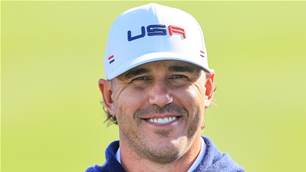
Koepka identifying with USA, not LIV

This is your time, Captain Donald's emotional message
